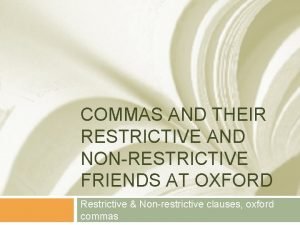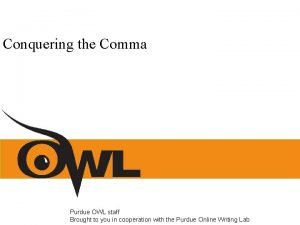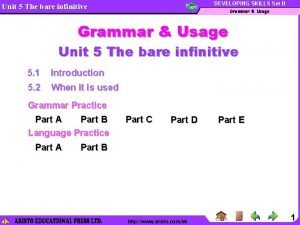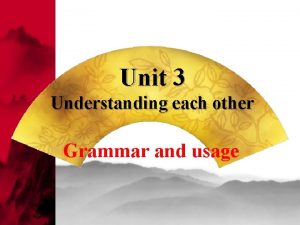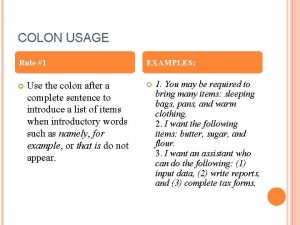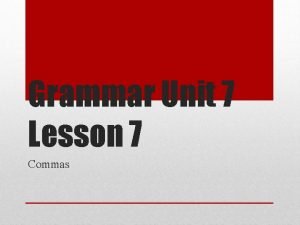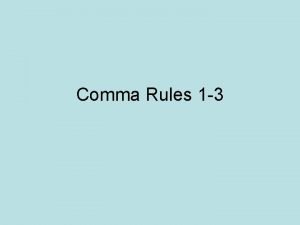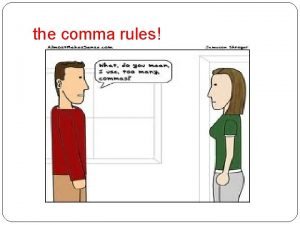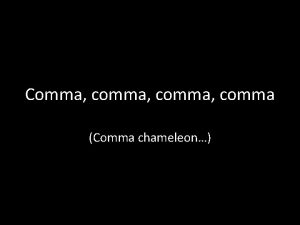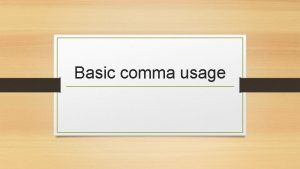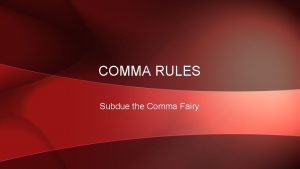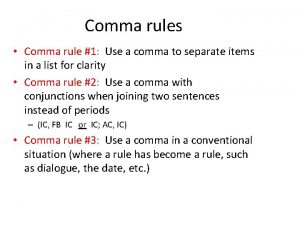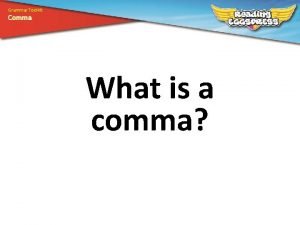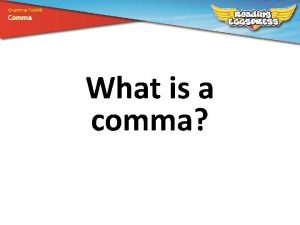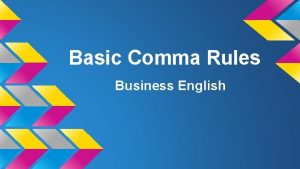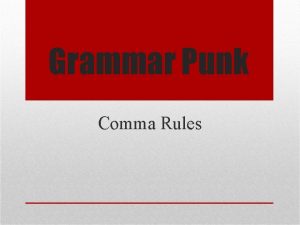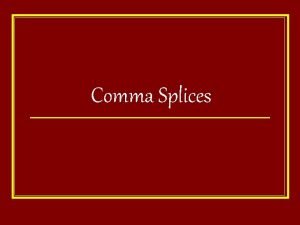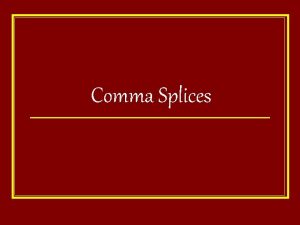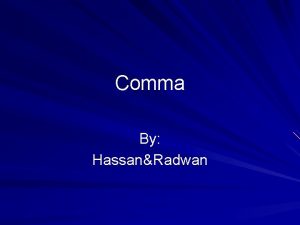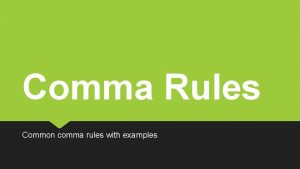Comma Rules Grammar and Usage 10 Key Rules














- Slides: 14

Comma Rules Grammar and Usage

10 Key Rules for Commas

Making Meaning Clear

Use a comma to separate items in a list (nouns and adjectives) �If you have more than two nouns or more than one adjective, you need to separate them with commas. In a list of nouns, you will separate the final two with the word “and” or the word “or” like this: Janet went to the store to buy pasta, broccoli, lemons, and beans. � Leaving out the comma after “lemons” is not incorrect, however the MLA style guide recommends using the serial comma.

In a list of adjectives… �…you only need two to use a comma, and if the adjectives come before the noun, don’t use “and. ” You only need to use “and” in a list of adjectives if the list comes after the verb “be. ” �Look at the following sentences: I have a big, old, warm quilt on my bed. The quilt on my bed is big, old and warm.

DON’T separate a subject from its verb with a comma �Even if the subject is very long and you feel like you need a comma because anyone reading it would have to pause for a breath, don’t do it. The president of the largest company in North America and his most trusted and esteemed board of advisors (no comma here) wish to see you immediately.

Use a comma to separate clauses, both dependent and independent Betty walks to work every day, talks to clients, � makes appointments, eats lunch, has afternoon meetings, and walks back home. Just like in the first rule, the final comma (after “meetings”) is not necessary in a list of dependent clauses, but as the clauses get longer, leaving out that last comma can get confusing, so it is often better to put it in just to clear things up. Betty gets home at 5: 30, she and her husband � have dinner together, they watch TV for a few hours, and they go to bed around 11: 00. When your clauses are independent (they could stand alone as complete sentences), it is absolutely necessary to use both the comma and the “and” before the final one.

Use a comma to set off a non-defining subordinate clause or an appositive � A non-defining subordinate clause gives some information about a noun, but the information is not necessary for identifying that particular noun. These clauses usually begin with “which” or “who. ” The Empire State Building, which was built in 1972, is still New York’s tallest building. � The non-defining subordinate clause, “which was built in 1972” gives some information about the Empire State Building, but we don’t need that information to identify the building or distinguish it from any other Empire State Buildings. It’s just extra information.

An Appositive… � …is similar, but it doesn’t include “which” or “who. ” It’s a word or phrase which can be substituted for a name. Bob Vance, the president of Vance Refrigeration, married my coworker Phyllis. � Here, you could identify Phyllis’s husband as either “Bob Vance” or “the president of Vance Refrigeration. ” They are the same person. � You will notice that short or one-word appositives such as in the phrase “my coworker Phyllis” do not have to be set off with commas.

Use a comma to set off expressions of contrast It was his money, not his looks, that first attracted me to him. He doesn’t look for charm in a restaurant, but service.

Use a comma to set off a quote. So she said to the guy, “Look, I don’t have to take this – not from you, ” and then she turned and walked away. “Please, ” he begged, “can’t we just talk about this? ”

Use a Comma… � …to signal that the main, independent clause is about to begin (when the sentence begins with something else) or that it is being interrupted. � Words that may be used to introduce or interrupt a sentence are: in fact, on the other hand, to tell the truth, yes, no, indeed, well, nevertheless, however, in my opinion, etc. The truth, in my opinion, is that we are all guilty in part. Indeed, I know that I am. However, I didn’t pull the trigger. Mrs. Peacock, on the other hand, did. If you have any doubts about this fact, please check her purse. You will find the gun there, I believe.

Use commas in addresses, dates and large numbers Portland, Oregon December 13, 2009 1, 945, 687, 238, 400

Use commas in the salutation and the closing expression of a letter Dear Aunt Carol, If you’re writing a business letter that is very formal, you might substitute a colon (: ) for the comma in the greeting. The closing, however, will always use a comma. Sincerely, Holly
 Comma comma comma chameleon meme
Comma comma comma chameleon meme Owl commas
Owl commas Developing skills grammar & usage set b answer
Developing skills grammar & usage set b answer Apposition grammar
Apposition grammar Unit 3 grammar and usage
Unit 3 grammar and usage Les appositions
Les appositions An/pyq-10c
An/pyq-10c Do i put a comma after dear
Do i put a comma after dear Left linear grammar
Left linear grammar Lesson 7 - review sentence structures and comma rules
Lesson 7 - review sentence structures and comma rules As well as comma
As well as comma What are the inadequacies of traditional grammar
What are the inadequacies of traditional grammar Type 0 grammar example
Type 0 grammar example Right linear grammar
Right linear grammar Comma rules list
Comma rules list
